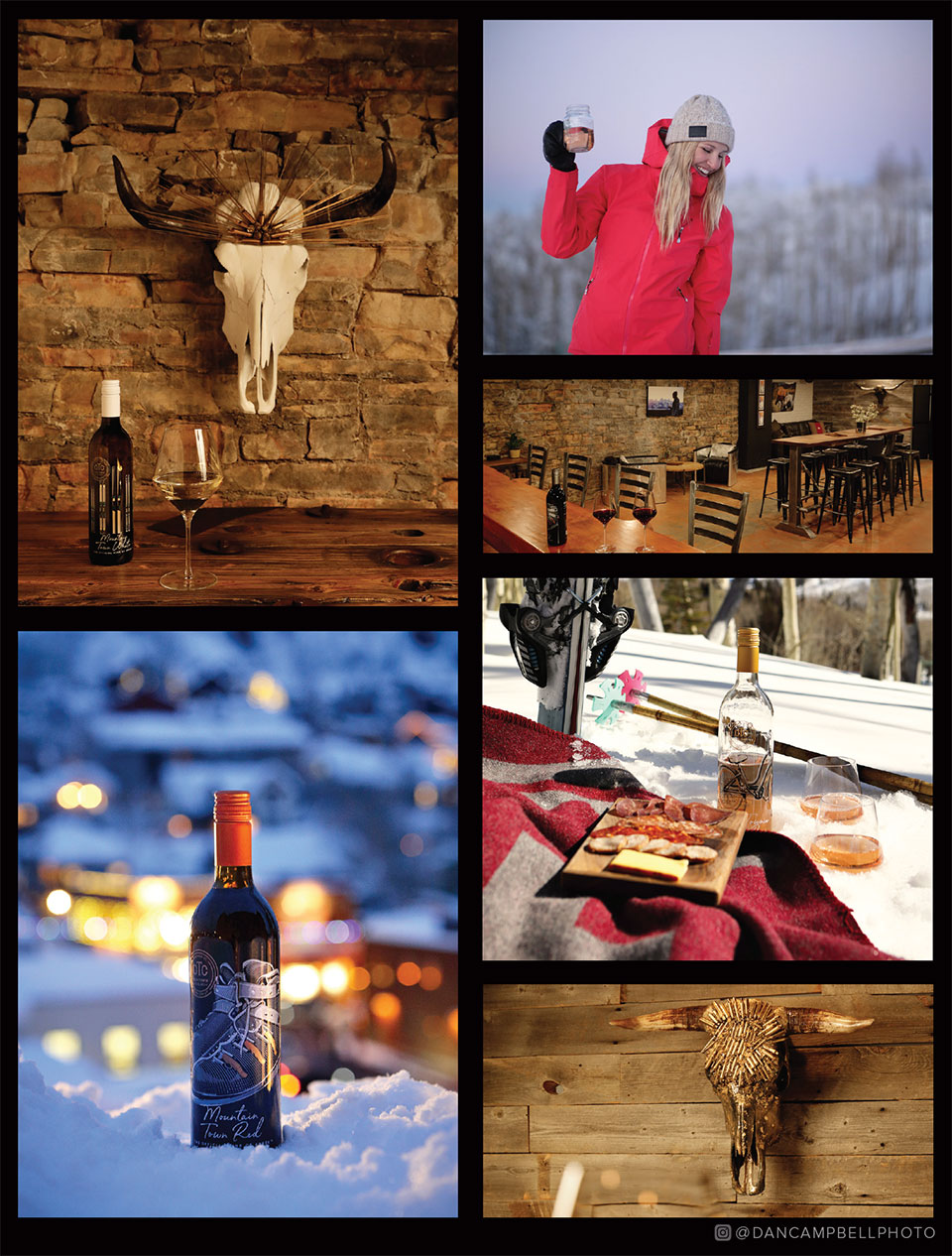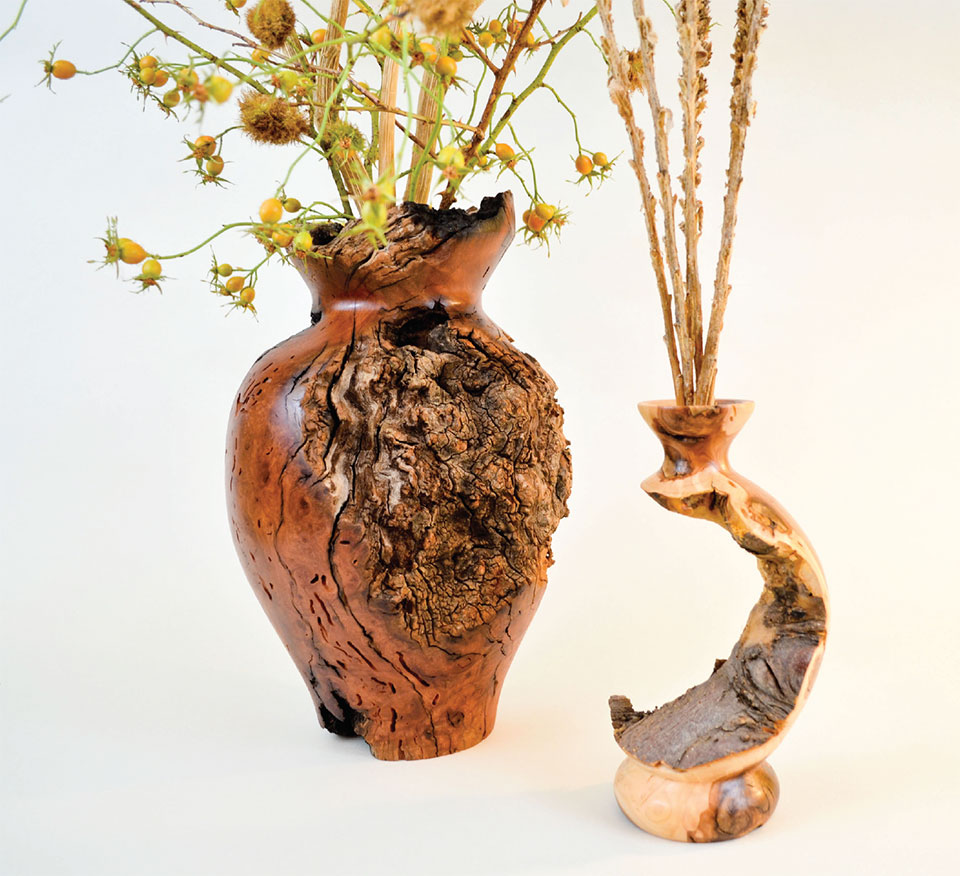Extracting & Refining
by Danielle Vigueria
Artists translate their interpretation of the world and give us new ways of experiencing life. They become masters of their medium and, through their own process, create valuable work that we all treasure. In our new normal with COVID-19, the need to celebrate art has never been greater.
In this feature, we first look at the art of woodturning with Paul Russell Designs. Paul refines the texture and surface of cut logs and trees, stripping away layers to reveal their internal essence. He masterfully crafts bowls, vases, and trays, as well as other organic pieces that you can build a room around.
Few things pair better with art than wine. From gallery walks to appreciating a beautiful work and the architecture it enhances, Old Town Cellars shares with us the art of winemaking and all that goes into their label. In times of stress as well as times of inspiration, artists are able to tap into their sensitivities and show us new perspectives through their work. We hope that after reading this, you’ll raise a glass of Old Town Cellars’ Mountain Town Red (or white or rosé!) and toast to living in such an inspiring place as Park City.
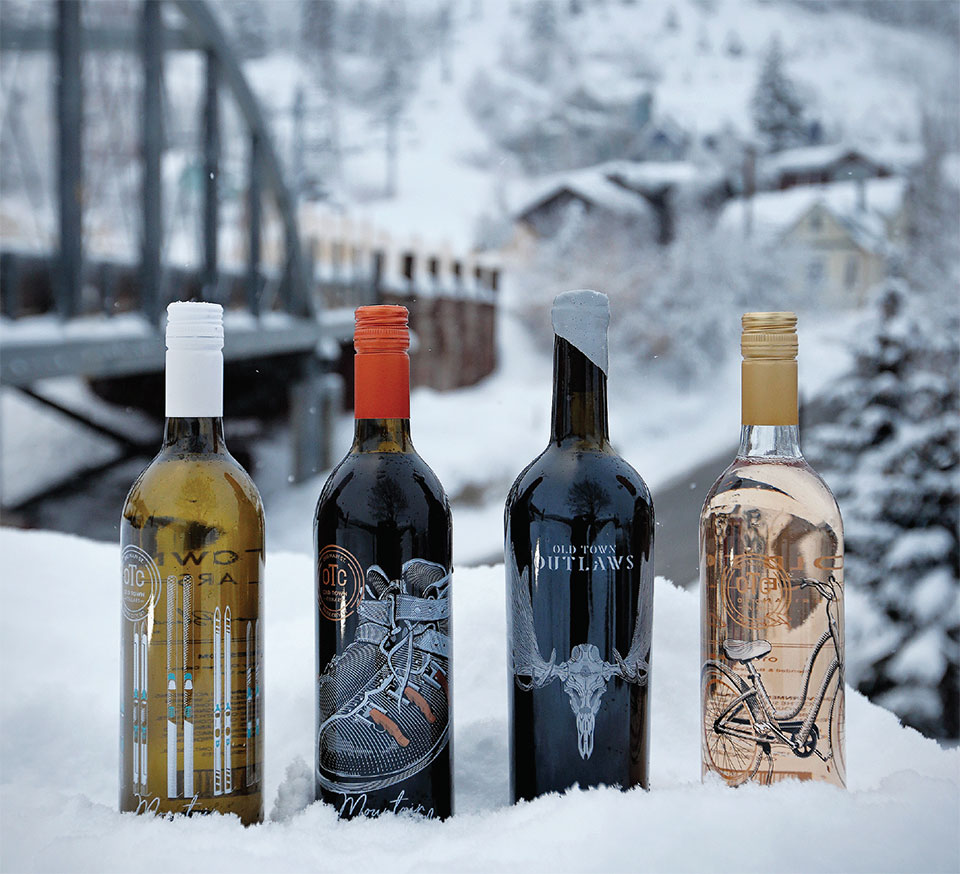
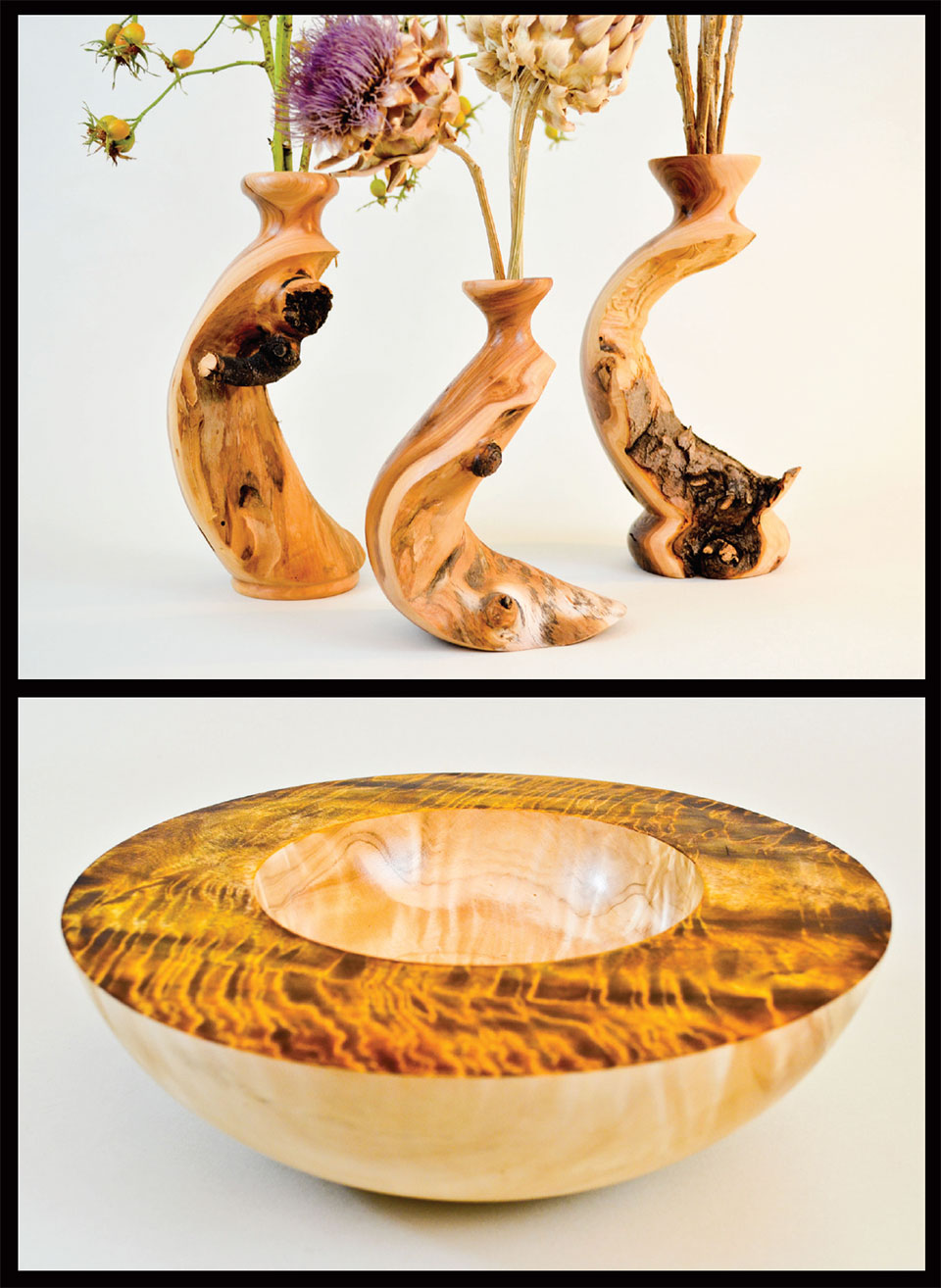
THE ART OF RUSTIC WOODTURNING
BRANCHING OUT
If Alberto Giacometti’s sculptures came to life, they would decorate their houses with Paul Russell’s Barely There series of vases. Paul Russell is a Utah-based rustic woodturner who sees the essential shape of vases, bowls, and trays hidden under the bark of a raw wood stump. Through his craft, Paul turns manzanita, lilac, and many other choice woods into pieces that you can design a whole room around.
Paul was first introduced to the art of woodturning in his high school shop class. He continued to study it in university, and when he finished school, he purchased the equipment to outfit a small backyard shop. He has outgrown his original shop, and now enjoys a newly expanded studio where he continues to work on traditional bowls, vases, platters, boxes, as well as his newest love, his Barely There series of dry vases.
“I’m finding much more interest in sculptural pieces,” Paul explains. “Part of the love of the Barely There pieces is that they give me the ability to take some oddly-shaped pieces of wood and reveal something so exotic and unique that you can design a room around them.”
The fun of it for Paul is translating the different shapes he sees in raw wood and amplifying the natural essence of a burl. Through a process that is equally as scientific as it is expressionistic, Paul turns the wood to reveal both expected and surprise characteristics. One of the more fun shapes Paul has been working with is what he calls the “bent elbows” of the tree. When most people cut a tree down, they cut the branches right at an elbow, so the logs are straight and can be efficiently stacked in firewood piles. Paul realized that he could do something truly unique with a bent branch. The first Barely There came from the burled elbow of a large lilac bush. “I saw the burl on the elbow of the lilac bush and thought, ‘I can’t put that in the fireplace, I have to do something with it,’” he recalls.
Historically, Paul collected any piece of reclaimed wood he could find and had huge wood piles in his backyard. Over the past several years, he’s been refining his selection to work with rich manzanita wood and the Giacometti-esque lilac branches. He has relationships with arborists and will hand-select burls and logs from their assortments in California, and also works with locally sourced woods. Paul highlights that his sourcing journey affords him the opportunity to interact with diverse people, because when someone’s offering you a log, they also share the story of the tree. That story becomes part of the unique concept behind the piece. Whether trees have been blown down, are part of a natural resource conservation effort, or removed from someone’s front yard, Paul rarely cuts down a tree for the purpose of his work. The focus is to repurpose woods harvested by others.
“I saw the burl on the elbow of the lilac bush and thought, ‘I can’t put that in the fireplace, I have to do something with it.’”
–Paul Russell, Paul Russell Design
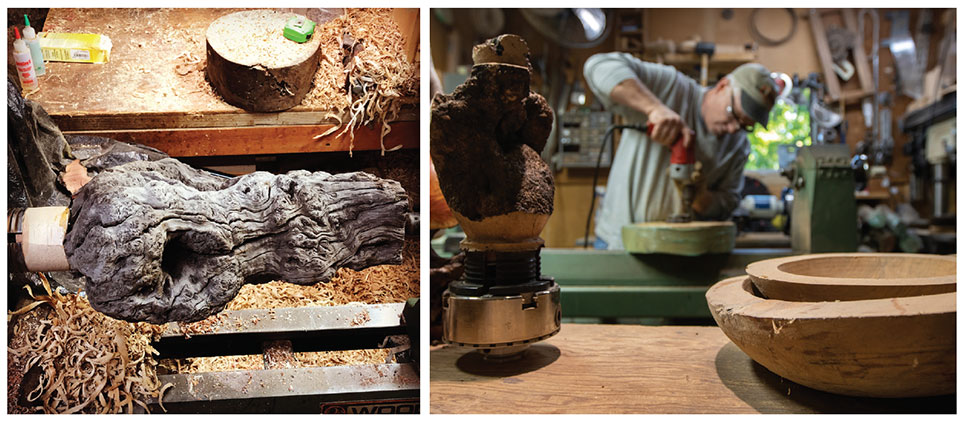
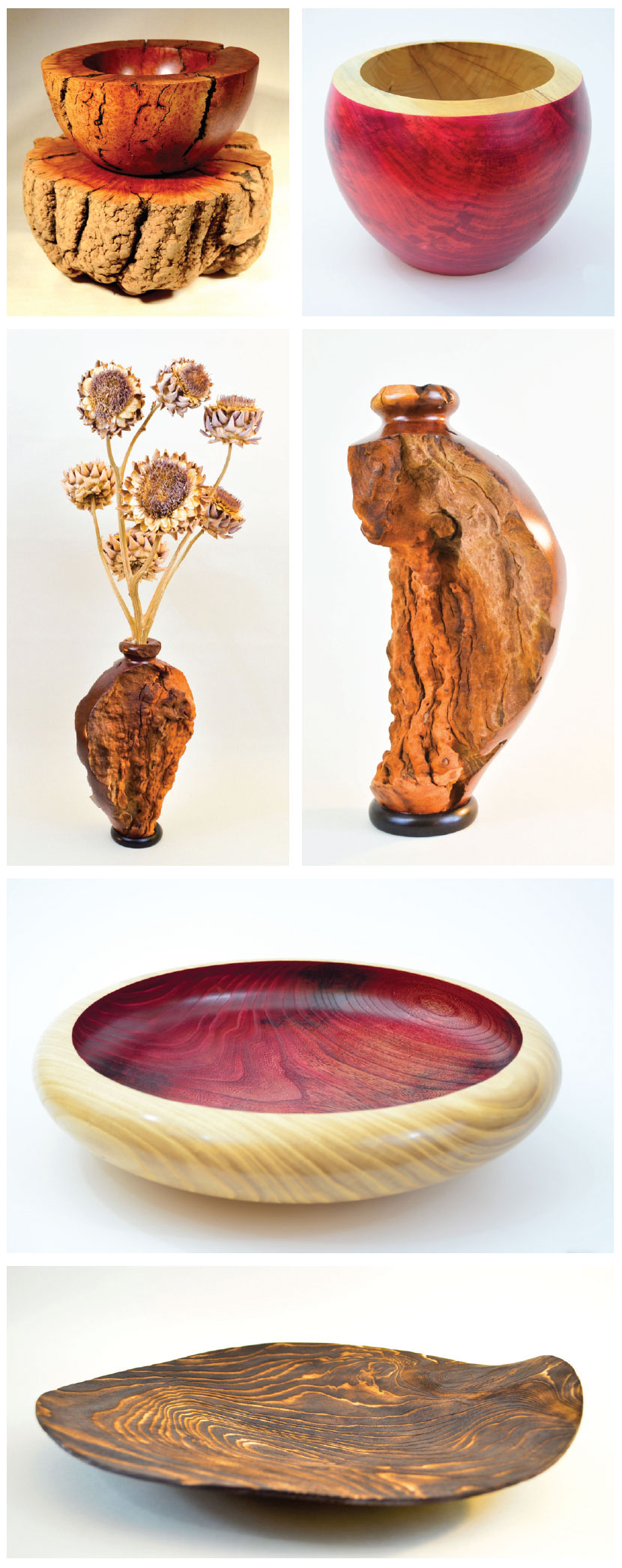
Paul tells the story of a bowl he turned from a burl on a plum tree in his neighbors’ yard. His neighbors had grown up with the tree and wanted to make sure something special was done with it when it was cut down. They brought the plum burl to Paul, who turned it into a natural-edge bowl. Ultimately, it was donated and sold at auction for a local youth group.
Paul’s work is evidence of the duality in nature between beauty and harshness. A burl is, in some respect, the manifestation of a tree trying to fight off something, or to protect itself. Paul explains that root burls are thought to be sources of water storage for plants in the dry environment of the Anza-Borrego Desert. Pieces of quilted cottonwood Paul has harvested reveal a chatoyant beauty of trunk fibers crushed under thousands of pounds of weight and stresses of being blown by winds and bowed in storms. Paul’s art highlights the powerful beauty of the tree’s resiliency and the ability of a living thing that can thrive even in the harshest conditions.
Paul’s contemporary works are illusive and captivating. They are, in reality, barely there. Each piece plays with the concept of negative space with each angle of the vessel offering more intrigue and discovery. The pieces are both rough and polished, elegant and raw, and they challenge us to complete the profile of the missing pieces of the form. In some cases, a bigger challenge is finding just the right twigs or dry flowers that will accentuate and complement the texture of the piece.
As methodical as the craft of woodturning is, Paul’s work is also expressionistic. “I can see the shape of the form in the raw piece and the features I want to amplify and ways to position the piece to accentuate the negative space while turning it,” he says. There’s an element of surprise in not knowing what it looks like under the bark. The fun for Paul is having an eye for finding just the right piece of burl or branch, or as he says, “When I see it, I know this is going to be one.” His art celebrates the journey of looking beneath the surface in our natural world and discovering an inner essence – where inside is outside, and outside is inside.
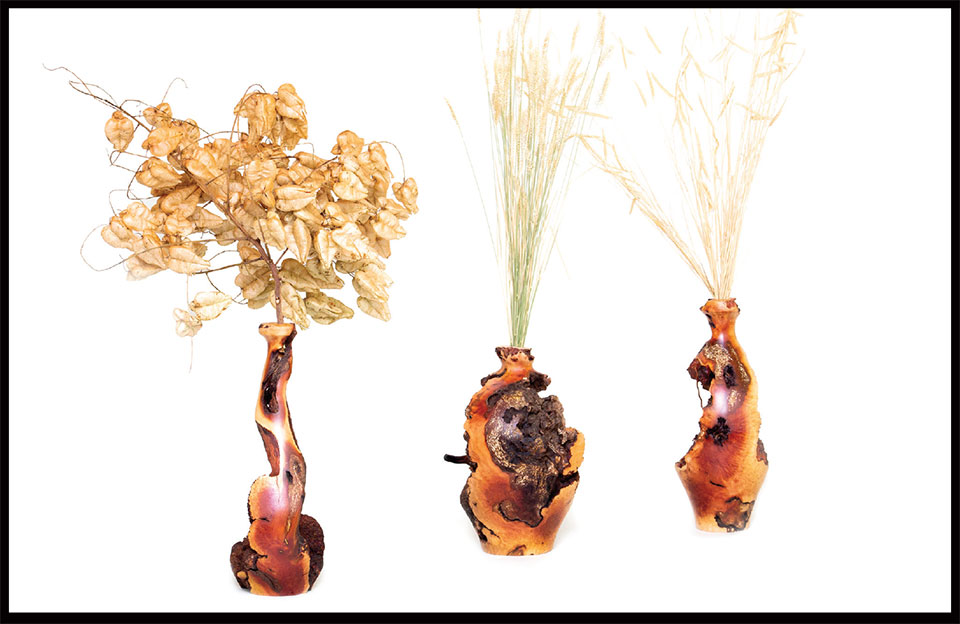
Trees reveal their entire provenance in their fibers. Accordingly, history is a theme in Paul’s work. Recently, he was approached to turn period-specific pieces for a cookbook on African cuisine. The author gave Paul photos and asked him to make historically and culturally accurate forms. He has also been approached by the Salt Lake Arts Council, for commission pieces from trees blown down in a recent storm in Salt Lake City, salvaging pieces as sustainable art. His works are also found in local and national exhibits and are used by designers and florists for weddings and other events.
Paul has been turning wood for decades, but recently has been focusing more exclusively on growing Paul Russell Designs as a business. While he continues to create his traditional pieces, his focus will be on his sculptural pieces. Paul’s newly expanded shop space will allow him to explore new techniques and ideas while implementing more texturing and embellishment into his sculptural pieces. As he turns more intricate pieces, he continues to challenge the definition of what it means to create a piece you can build a room around.
“I can see the shape of the form in the raw piece and the features I want to amplify and ways to position the piece to accentuate the negative space while turning it.”
—Paul Russell, Paul Russell Design

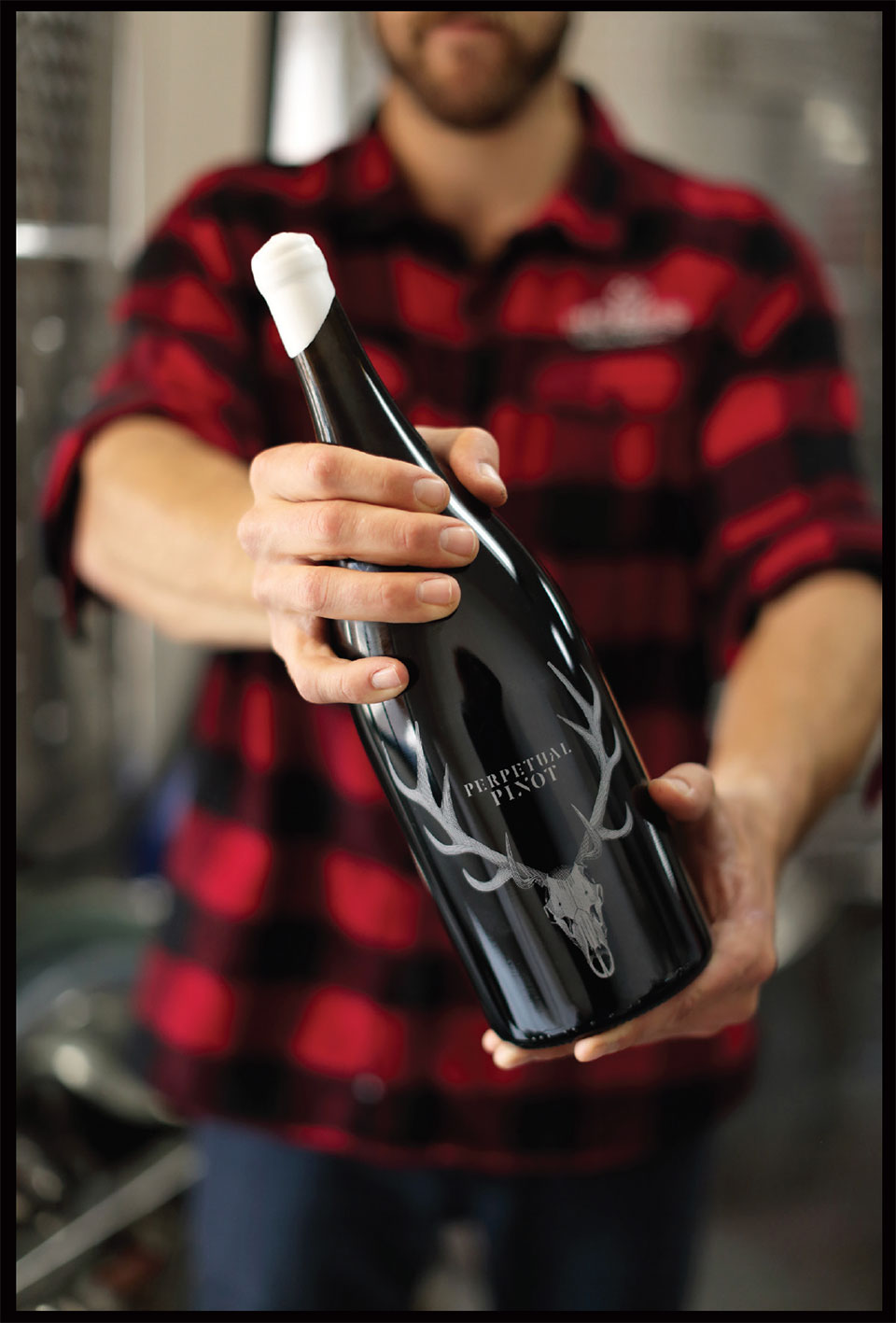
The Art of Blending for All
Old Town Cellars
Oftentimes, the world of wine may feel like an intimidating club, reserved for those with highly trained palates and deep pockets. But Stephen MacKay and Jason Morgan, owners of Old Town Cellars in Park City, are working to change that. They have created a winery that embraces the art of winemaking in an accessible and welcoming way. From the décor and the laid-back ambiance of the space to their unique wine bottles and the wines within them, oTc is a celebration of individual expression, inclusivity, and good old-fashioned fun.
The Wines
“One of the biggest draws for me is the subjectivity involved in wine,” says Jason. “During the winemaking process, there are different characteristics you’d like to pull out of different grapes. Like other forms of art, it is an individual experience.”
Since opening in the spring of 2016, oTc has been turning traditional concepts in the wine industry upside-down. Every year, Jason and Stephen travel to Oregon’s Umpqua Valley to join oTc head winemaker, Charlie Kidd, while he begins the winemaking process. The grapes are harvested, custom-crushed, and fermented in Oregon, and once stable, brought back to oTc to be blended and bottled right on Main Street.
“Charlie is a mentor and friend. He is not only our head winemaker, but he grows the grapes as well—by heart a farmer; a winemaker by accident,” says Stephen. “He is a trained viticulturist with wicked creativity and he comes up with exceptionally great ideas for our blends.”
Making unique blends is something that is important to the team at oTc. They strive to create wines that haven’t been seen in the marketplace before—true original works, describing their wine style as, “Old World palate with new world fruit.” They are always sourcing the best available wines for their blends, keeping in mind how each will pair with the local, seasonal foods of the mountains they call home.
The oTc wines often break with established stereotypes. All Rieslings are sweet, right? Not the case when it comes to Old Town Cellar’s Mountain Town White, an Alsace-style field blend with pepperiness and viscosity. And their Townie Rose, which is traditional southern French, light, and off-dry, brings an unexpected acidity.
Planning to have eight wines available for 2021, the crew at oTc is currently working on a few new projects, including a Paso Robles Cabernet blend, a new Pinot Noir, and a whiskey barrel-aged Tempranillo that has hints of warm baking spices and the caramel notes of a nice whiskey.
Not only are the oTc wines one-of-a-kind, but Jason and Stephen also believe that making those exceptional wines feel approachable starts with the right branding. All of their bottles showcase imaginative, hand-drawn designs. The artwork, created in collaboration with Highlo Designs in Park City, highlights the heart and humor that the team brings to their winemaking.
“During the winemaking process, there are different characteristics you’d like to pull out of different grapes. Like other forms of art, it is an individual experience.”
–Jason Morgan, Owner, Old Town Cellars
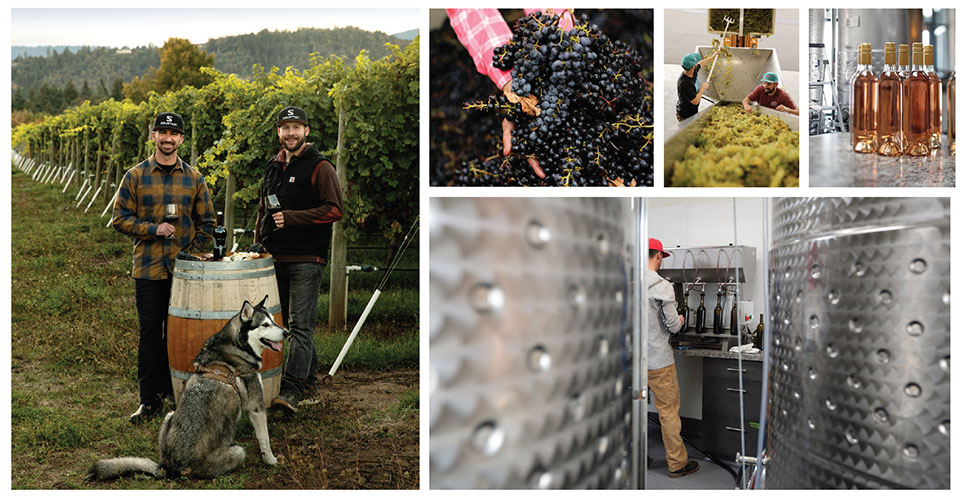
As a nod to the natural beauty of Utah, several of the wine labels feature drawings of skulls of animals indigenous to the area. The Old Town Outlaws, a bold red with notes of red fruit, cedar, and compote, shows a moose’s skull. The Perpetual Pinot, Jason’s favorite, displays a majestic elk skull. oTc’s Elusive, a moderately-oaked Chardonnay, is decorated with a mountain lion skull—a subtle nod to “ski-town cougars,” says Stephen with a smile.
That spirit of fun and lightheartedness of sharing a joke is part of what makes oTc so accessible—smart wine without the big ego. “We really try to make our wines approachable for every palate and affordable for every price point,” says Stephen. Their flagship red wine, Mountain Town Red, is priced below $20.
oTc Bar & Lounge
To complement their approachable wines, oTc has created the perfect setting for people to sit and share a bottle. From the lighting and the music to the artwork on the walls, the lounge is warm and friendly. It is a continuation of the celebration of creativity that oTc embodies.
“Hospitality is a bit of a lost art form today,” says Jason. “Wine bars are sometimes associated with a pretentious or arrogant feeling; we aim to be welcoming. We don’t have any TVs in the bar; we want this to be a social spot, to reignite conversations, to get people off their phones and interacting with each other.”
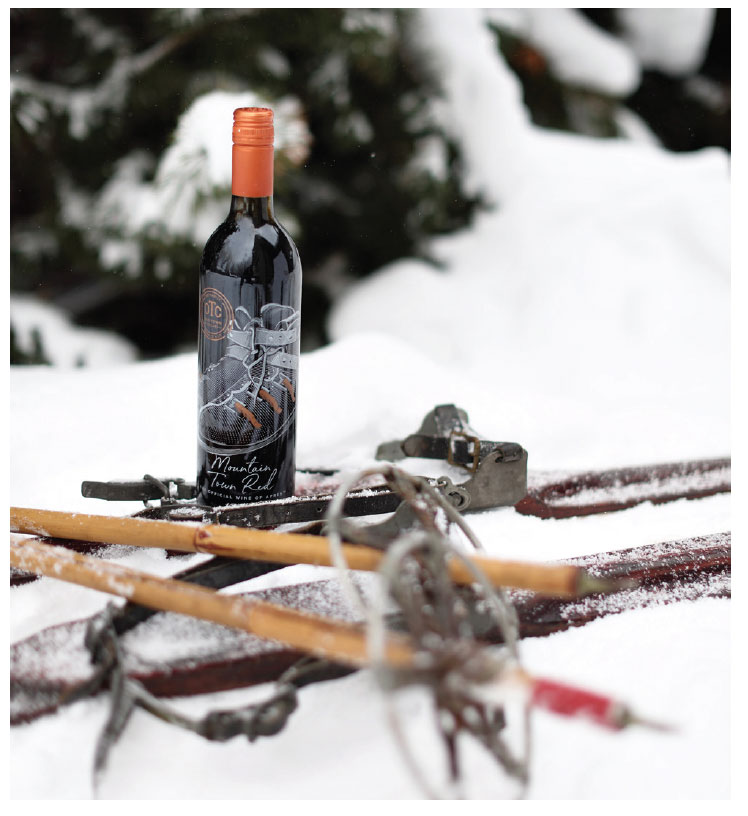
The space, a previously functioning silver vault from the 19th century, survived the fire of 1898 that devastated Park City. Still standing on the original foundation, the lounge contains a new bar made from beetle-kill spruce and modern, rustic furniture, providing an apt combination of old and new, just as the oTc wines themselves do.
Photography that captures the best of mountain living from Dan M. Campbell hangs on the exposed brick walls and reflects the passion Stephen and Jason, both Park City natives, have for their community. Bejeweled animal skulls from artist Allison Badell of Gypsy Mountain Skulls shimmer around the room and bring to mind the drawings on the oTc wine labels.
“I have always valued Dan Campbell’s photography,” says Jason. “He is a talented artist. And incorporating Allison Badell’s skulls into the lounge has also been an interesting, fun avenue to go down. What she does with her art—taking such a unique, unexpected spin on animal skulls and taxidermy—we are doing that same thing with wine. We are both trying to shake up our industries and bring more individualism and personality.”
“Working with Dan, Allison, and Highlo Designs felt like pieces of a puzzle clicking together,” says Stephen. “Our partnerships, friends, and families make oTc successful. They all continue to believe in us and want to work with us. We would not be where we are without them. We are a tight-knit group. We are all artists, just in different ways.”
“We are just trying to show people that wine can be fun and inviting. Sometimes it can be difficult to keep things light, especially in business today, but in the end, we are all here to have a good time.”
–Stephen MacKay, Owner, Old Town Cellars
The Future is for Everyone
Empowered by their art and fellow artists, oTc is breaking down preconceived ideas about wine by mixing things up a bit, using science and imagination to create unique blends that can be enjoyed by everyone. “The Official Wine of Après,” they are a great addition to any dinner party, backyard barbecue, or campfire hangout.
“We are very transparent,” says Jason. “We are honest with our process and the varietals we use. We aren’t afraid to take risks to break down the stereotypes that surround wine and show people that winemaker expression is as important as the grape itself.”
Always open to expanding their community, the team at oTc has their hands in lots of new projects. They are currently exploring the possibilities of developing CBD-infused wine and high-quality, non-alcoholic grape juice. They are also planning a trip to Argentina and will be on the lookout for interesting fruits to incorporate in their next batch.
“It’s crazy to think that, one night, over a few bottles of wine during a ski trip in Tahoe, Stephen and I talked about this idea,” says Jason. “We drew it up on a napkin and now five years later, here we are.”
“We are just trying to show people that wine can be fun and inviting,” says Stephen. “Sometimes it can be difficult to keep things light, especially in business today, but in the end, we are all here to have a good time.”
